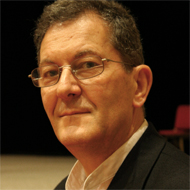Petr Kotik was born as a son of the visual artist and painter Jan Kotik (his grandfather was also significant Czech painter Pravoslav Kotik). He studied flute at the Prague Conservatory and Academy of Music with Frantisek Cech and at the Music Academy in Vienna with Hans Reznicek. From 1960 to 1963, he studied composition privately with Jan Rychlik in Prague, and later from 1963 to 1966 at the Music Academy in Vienna with Karl Schieske, Hans Jelinek, and Frederich Cerha. In 1961 he founded and directed the ensemble Musica Viva Pragensis (1961-1964) and the QUAX Ensemble (1966-69), both based in Prague. In 1969, Kotik came to the U.S.A. at the invitation of Lerajen Hiller and Lucas Foss to join the Center of the Creative and Performing Arts at the University of Buffalo. He is the founder and director of the S.E.M. Ensemble, which has performed, since 1970, a yearly series of concerts in New York and toured the U.S. and Europe. In 1974, he prepared for publishing the entire musical work of Marcel Duchamp, which was issued on LP by Multhipla in 1978, and on CD by Renee Block Editions in 1991. Between 1978 and 1982, Kotik toured South America three times as a composer, performer, and lecturer. Kotik lived in Buffalo, New York until 1983, when he moved to New York City where he lives and works as an independent composer, performer and director of the S.E.M. Ensemble. From 1971 to 1977, Kotik taught flute at the State University of New York at Buffalo. Since the early 1980s Kotik began to conduct, concentrating mainly on the music of John Cage. In the fall of 1991 Kotik has founded the Orchestra of the S.E.M. Ensemble which became in a short time internationally recognized as one of the foremost large scale new music groups. His conducting engagements, both in the USA and Europe, included premieres of works, among others, by David First, Somei Satoh, and Leo Smith, as well as works by Feldman, Cage, and Varese. In 1999 Kotik initiated and is the artistic director of the Ostrava Center for New Music (OCNM) to produce Ostrava Days Summer Institute, as well as other concerts and publications related to new music events. Petr Kotik is married to Charlotta Kotik, curator of contemporary art at the Brooklyn Museum. They have two children, Thomas and John (born 1969 and 1972).
Since his early works, Kotik's compositional method has been based on visually graphic material. Using graphs that were created without direct relation to his music, Kotik has determined all of his musical parameters. While making his own graphic scores in the 1960s, in 1971 Kotik began to use new graphic material which he accidentally discovered at his friend Jan Kucera's medical lab at the University of Buffalo. Kucera's graphs charted the results of experiments on the reaction of the nervous system to alcohol. Kotik used these until 1982, when he developed, with the assistance of Charles Ames, a computer program that produced chance progressions based on Markov's numerical chain process. Kotik applies these computer-generated progressions, like his earlier graphs, to all musical parameters.
Kotik\'s compositional concept is based largely on the relationship between random occurrence and conscious control. His method can be described as a game in which regulated chance leads to situations that require decisions to be made by the composer. The results, which are often unpredictable, are either left alone or further edited by the composer.
Kotik describe his music in the following manner: "I have been always most myself in a clear and direct way. In my music, I strive to achieve directness, clarity and simplicity. My method of composing is linear: I work separately with each voice and combine them horizontally. Each voice part becomes a layer in the resulting piece. Between 1970 and 1983, most of my compositions consisted of independent parts. These parts can be performed as solos or combined with other parts into ensembles. The overlappings are left to the performers who either plan them in advance or create them spontaneously during performances. Since 1983,a greater concern for tonality led me to a tighter control of the musical material. Each voice/part is still composed individually, but the final form is edited into a fixed score."
All of Kotik's compositions from 1970 to 1983 have no fixed instrumentation. Although each part was composed with a specific instrument or voice in mind, they can all be transposed and performed by other instruments or voices. His later scores combine fixed instrumentation with some possibilities for octaves or fifths transposition. This concept of instrumentation is similar to that which was common for Baroque music: only a part of a score requires prescribed instruments, the rest can be adjusted according to the possibilities of each performance situation. Since the mid 1970s, Kotik has been doubling some parts, using perfect intervals: fifths, fourths, and octaves. Even though his recent pieces involve more complex harmonies, the basic structure of the chords it still based on fifths, fourths, and octaves.

